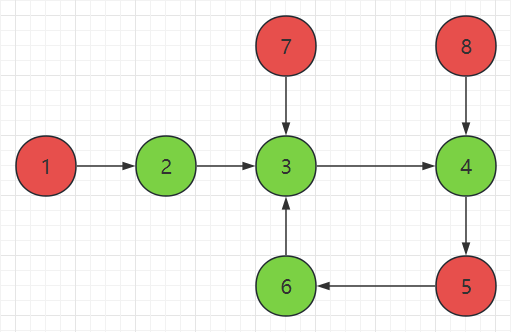模拟。
1 2 3 4 5 6 7 8 9 10 11 12 13 14 15 16 17 class Solution { public List<Integer> lastVisitedIntegers (List<String> words) { int idx = -1 ; List<Integer> ans = new ArrayList <>(); List<Integer> aux = new ArrayList <>(); for (String word : words) { if (word.equals("prev" )) { if (idx < 0 ) ans.add(-1 ); else ans.add(aux.get(idx--)); } else { aux.add(Integer.valueOf(word)); idx = aux.size() - 1 ; } } return ans; } }
贪心。
1 2 3 4 5 6 7 8 9 10 11 class Solution { public List<String> getWordsInLongestSubsequence (int n, String[] words, int [] groups) { List<String> ans = new ArrayList <>(); for (int i = 0 ; i < n; i++) { if (i == n - 1 || groups[i] != groups[i + 1 ]) { ans.add(words[i]); } } return ans; } }
和最长递增子序列有点像,处理的时候记录一下路径就好。
1 2 3 4 5 6 7 8 9 10 11 12 13 14 15 16 17 18 19 20 21 22 23 24 25 26 27 28 29 30 31 32 33 34 35 36 class Solution { public List<String> getWordsInLongestSubsequence (int n, String[] words, int [] groups) { int pos = 0 ; int [] from = new int [n]; int [] maxLen = new int [n]; Arrays.fill(maxLen, 1 ); for (int i = 1 ; i < n; i++) { for (int j = i - 1 ; j >= 0 ; j--) { if (maxLen[i] < maxLen[j] + 1 && groups[i] != groups[j] && words[i].length() == words[j].length()) { int cnt = 0 ; for (int k = 0 ; k < words[i].length(); k++) { if (words[i].charAt(k) != words[j].charAt(k) && ++cnt > 1 ) { break ; } } if (cnt == 1 ) { maxLen[i] = maxLen[j] + 1 ; from[i] = j; if (maxLen[i] > maxLen[pos]) { pos = i; } } } } } int m = maxLen[pos]; LinkedList<String> ans = new LinkedList <>(); for (int i = 0 ; i < m; i++) { ans.addFirst(words[pos]); pos = from[pos]; } return ans; } }
明显是多重背包问题,求背包中物品重量在 \([l,r]\) 之间的方案数,朴素的转移方程为:
$$
dp[i][j]=\sum_{k=0}^{cnt[i]}{(dp[i-1][j-k\cdot w[i]])}
$$
这样做的时间复杂度为 \(O(rn)\),其中 \(n\) 为 \(nums\) 的长度。在题目的数据范围下,复杂度达到 \(4\cdot 1e8\) 数量级,会导致超时。优化方式如下,当 \(j\geq(cnt[i]+1)\cdot w[i]\) 且 \(w[i]\neq 0\) 时,有:
$$
dp[i][j-w[i]]=dp[i-1][j-w[i]]+dp[i-1][j-2\cdot w[i]]+\cdots+dp[i-1][j-(cnt[i]+1)\cdot w[i]]
$$
$$
dp[i][j]=dp[i-1][j]+dp[i-1][j-w[i]]+\cdots+dp[i-1][j-cnt[i]\cdot w[i]]
$$
然后错位相减,得到:
$$
dp[i][j]=dp[i][j-w[i]]+(dp[i-1][j]-dp[i-1][j-(cnt[i]+1)\cdot w[i]])
$$
当 \(j\geq(cnt[i]+1)\cdot w[i]\) 且 \(w[i]=0\) 时,直接使用朴素转移方程,得到:
$$
dp[i][j]=\sum_{k=0}^{cnt[i]}{(dp[i-1][j])}
$$
同理可得,当 \(w[i]\leq j<(cnt[i]+1)\cdot w[i]\) 时,错位相减得到:
$$
dp[i][j]=dp[i][j-w[i]]+dp[i-1][j]
$$
当 \(j<w[i]\) 时,直接使用朴素转移方程,得到:
$$
dp[i][j]=dp[i-1][j]
$$
这样做的时间复杂度为 \(O(r\sqrt{S})\),其中 \(S\) 表示 \(nums\) 的元素和,\(\sqrt{S}\) 表示 \(nums\) 中不同元素的最大数量。不同元素的最大数量满足 \(\frac{(0+(x-1))\cdot x}{2}\leq S\),解得 \(x\leq \frac{1+\sqrt{1+8\cdot S}}{2}\)。还有一些常数级别的优化,比如减少遍历的上界等。
1 2 3 4 5 6 7 8 9 10 11 12 13 14 15 16 17 18 19 20 21 22 23 24 25 26 27 28 29 30 31 32 33 34 35 36 37 class Solution { private static final int MOD = (int ) 1e9 + 7 ; public int countSubMultisets (List<Integer> nums, int l, int r) { int n = nums.size(); Map<Integer, Integer> map = new HashMap <>(); for (int x : nums) { map.merge(x, 1 , Integer::sum); } int zero = map.getOrDefault(0 , 0 ); map.remove(0 ); int m = map.size(); int [] f = new int [r + 1 ]; int [] g = new int [r + 1 ]; f[0 ] = zero + 1 ; for (var e : map.entrySet()) { int w = e.getKey(), c = e.getValue(); System.arraycopy(f, 0 , g, 0 , r + 1 ); for (int j = w; j <= r; j++) { f[j] = (f[j - w] + f[j]) % MOD; if (j - (c + 1 ) * w >= 0 ) { f[j] = (f[j] - g[j - (c + 1 ) * w] + MOD) % MOD; } } } int ans = 0 ; for (int i = l; i <= r; i++) { ans = (ans + f[i]) % MOD; } return ans; } }
分开处理,先做前缀和,再倒序减去某个前缀和,就可以不使用辅助数组 \(g\):
1 2 3 4 5 6 7 8 9 10 11 12 13 14 15 16 17 18 19 20 21 22 23 24 25 26 27 28 29 30 31 32 33 34 35 class Solution { private static final int MOD = (int ) 1e9 + 7 ; public int countSubMultisets (List<Integer> nums, int l, int r) { int n = nums.size(); Map<Integer, Integer> map = new HashMap <>(); for (int x : nums) { map.merge(x, 1 , Integer::sum); } int zero = map.getOrDefault(0 , 0 ); map.remove(0 ); int m = map.size(); int [] f = new int [r + 1 ]; f[0 ] = zero + 1 ; for (var e : map.entrySet()) { int w = e.getKey(), c = e.getValue(); for (int j = w; j <= r; j++) { f[j] = (f[j - w] + f[j]) % MOD; } for (int j = r; j >= (c + 1 ) * w; j--) { f[j] = (f[j] - f[j - (c + 1 ) * w] + MOD) % MOD; } } int ans = 0 ; for (int i = l; i <= r; i++) { ans = (ans + f[i]) % MOD; } return ans; } }
